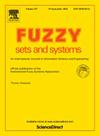A design of sliding mode control for uncertain T-S fuzzy systems with multiple input matrices
IF 3.2
1区 数学
Q2 COMPUTER SCIENCE, THEORY & METHODS
引用次数: 0
Abstract
This paper investigates how to design a sliding mode surface and construct a sliding controller to stabilize a uncertain T-S fuzzy system with multiple input matrices and matched disturbances. The method proposed in this paper can expand the effective scope of sliding mode control into uncertain fuzzy systems even if there are not assumptions of input matrices. In order to expand the effective scope of controlled systems, firstly, transform the form of input matrices of system plants into a new input matrix B. Secondly, design a new sliding mode surface according to all the input matrices. It contains q sub-sliding surfaces. The number q is the column number of input matrix B. Thirdly, according to sliding mode theorem, the equivalent controller can be deduced. But, it may be nonexistence. A judgment criterion for the existence of the controller is given as a lemma. By use of the proposed sliding surface, a new sliding controller is constructed. It can settle the confliction difficult between sliding surface and input matrices. And it can make the system reach the sliding surface and keep on it thereafter. At last, two examples are given to illustrate the effectiveness of this paper.
具有多输入矩阵的不确定 T-S 模糊系统的滑模控制设计
本文研究了如何设计滑动模态面和构建滑动控制器,以稳定具有多个输入矩阵和匹配干扰的不确定 T-S 模糊系统。即使没有输入矩阵假设,本文提出的方法也能将滑模控制的有效范围扩大到不确定模糊系统。为了扩大控制系统的有效范围,首先要将系统植物的输入矩阵形式转换为新的输入矩阵 B。其次,根据所有输入矩阵设计新的滑模面。它包含 q 个子滑动面。q 是输入矩阵 B 的列数。第三,根据滑模定理,可以推导出等效控制器。但是,它可能不存在。现给出一个控制器是否存在的判断标准,作为一个两难问题。利用所提出的滑动面,构建了一个新的滑动控制器。它能解决滑动面与输入矩阵之间的冲突难题。它还能使系统到达滑动面并保持在滑动面上。最后,本文举了两个例子来说明其有效性。
本文章由计算机程序翻译,如有差异,请以英文原文为准。
求助全文
约1分钟内获得全文
求助全文
来源期刊

Fuzzy Sets and Systems
数学-计算机:理论方法
CiteScore
6.50
自引率
17.90%
发文量
321
审稿时长
6.1 months
期刊介绍:
Since its launching in 1978, the journal Fuzzy Sets and Systems has been devoted to the international advancement of the theory and application of fuzzy sets and systems. The theory of fuzzy sets now encompasses a well organized corpus of basic notions including (and not restricted to) aggregation operations, a generalized theory of relations, specific measures of information content, a calculus of fuzzy numbers. Fuzzy sets are also the cornerstone of a non-additive uncertainty theory, namely possibility theory, and of a versatile tool for both linguistic and numerical modeling: fuzzy rule-based systems. Numerous works now combine fuzzy concepts with other scientific disciplines as well as modern technologies.
In mathematics fuzzy sets have triggered new research topics in connection with category theory, topology, algebra, analysis. Fuzzy sets are also part of a recent trend in the study of generalized measures and integrals, and are combined with statistical methods. Furthermore, fuzzy sets have strong logical underpinnings in the tradition of many-valued logics.
 求助内容:
求助内容: 应助结果提醒方式:
应助结果提醒方式:


